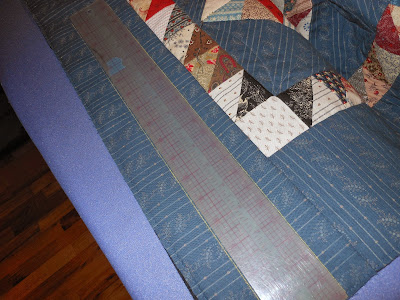I actually "finished" it a few weeks ago, ie quilted all the blocks - albeit sparsely, thinking that was all it really needed - and put the binding on. So it is technically finished.
Simple quilting in the ditch here.
Some of the blocks called for a little more detail, so I obligingly gave them the appropriate extra stitching.
Of course as soon as that happened, one by one some of the other already sparsely quilted blocks got the idea that they needed more. So here I am, going back over and adding more quilting to several more blocks.
So this block looks like this now (minus the white marking lines).
And several more I've added to:
I even started experimenting with quilting the sashing, which you can see here. I have to admit, those three little ovals look pretty dang cute.
This one (above) could still use a little more quilting, I think...
Maybe this one too? see that's the problem, I'm not sure where to stop.
The whole other thing is, I am so enjoying the process of quilting these blocks, part of me doesn't want it to end. Being a sampler, each block has been like its own little project - from the fabric selection and piecing, to the quilting. Whenever I finish a block, I find I can't wait to start the next one.
Although I keep within a theme with my quilting and some motifs - notably the "orange peel" (why do they call it this, anyway?) - are repeated frequently, each block presents a new opportunity or different challenge, and the result from one to another. I find this both exciting, and visually rewarding.
Knowing when to stop is definitely a problem. At this point I don't think I want to add more quilting to the setting blocks - really, I don't - and I don't think I really want to quilt the sashing ... or do I??
I'm afraid the more quilting I put in, the more it will demand. And because I don't want to wreck my hands, this may end up being an ongoing and very lengthy project! The good news is, the binding is on so I'm already using the quilt (I put it on my bed at my quilt retreat last month) however I doubt I'll wash it until "all" the quilting is in, whenever that may be ~ ~ ~
Meanwhile, I finished my little Bow Tie quilt over the weekend, and have attempted to stage it in a nice vignette for your viewing pleasure ~
 |
| Bow Tie with Rhubarb, Yard Junk and Drip Irrigation |
 |
| Bow Tie on Bench with Fallen Maple Leaves |
***a note on hand quilting***
Since I started quilting something like 25 or so years ago, I've always started off my quilting line by simply burying the knot then continuing with the running stitch, and ending in much the same way - a small knot, pulled straight into the batting away from the quilting line. I've never had any problem with this method, and never had any knots pull out. Now for some reason - I suppose I read somewhere along the line that this was not "good enough" I started doing a back stitch at the beginning after burying the knot, and at the end before the knot. Well guess what. I've noticed places where the knot has pulled out and is now sitting on top of the quilt. And where that hasn't happened, the first and/or last stitch are often "baggy". Not pretty. I really don't know how to correct this once its done, beyond pulling the stitch line out and starting over. I've already done this in a few instances, but mostly its just too fussy and I've decided I'll just have to live with my mistake. Needless to say, I am now back to my old method. I would love to hear your comments on this.
love,
Sandy



































